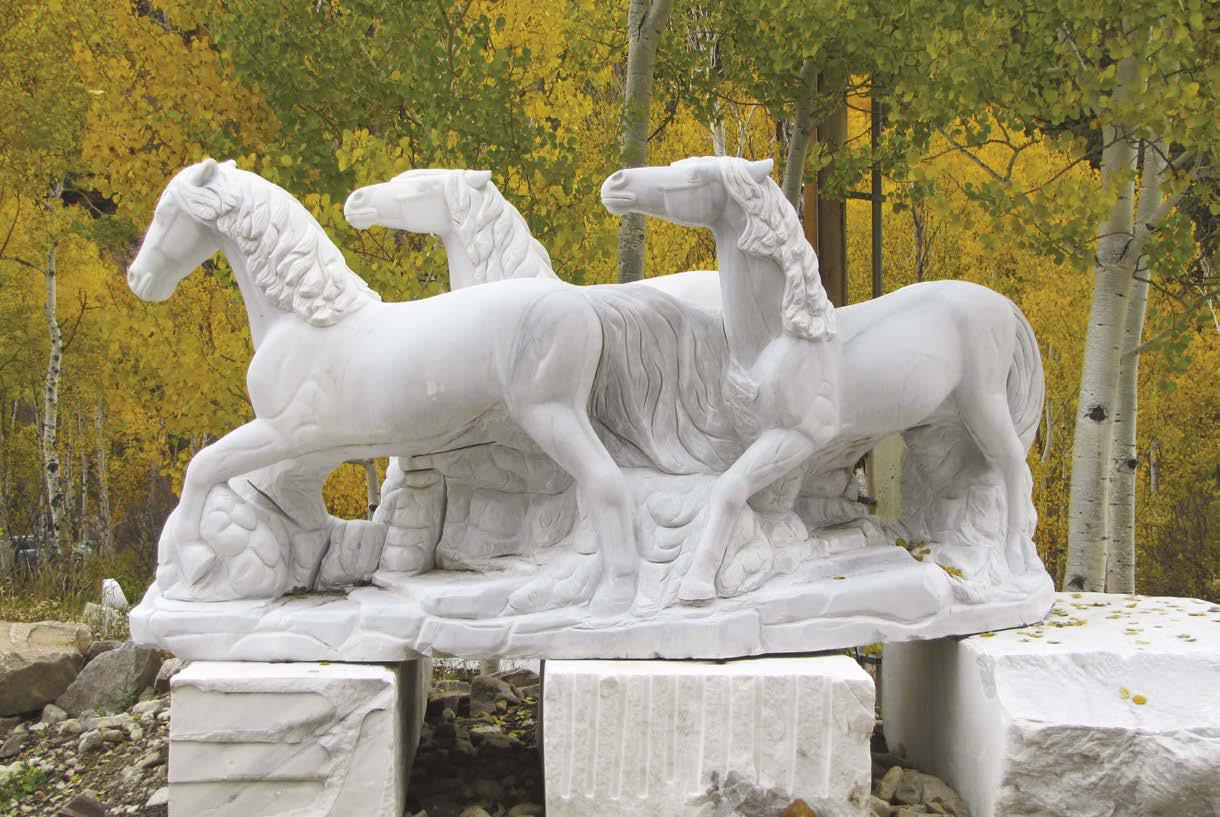Versuchen GOLD - Frei
THE MAGIC OF MARBLE
Rock&Gem Magazine
|December 2022
Sculptors and architects have an abundance of natural stone materials to choose from alabaster, travertine, granite, limestone and soapstone to name a few. But one medium has always stood out - marble. For the last 2,500 years, marble has been chosen for many of the greatest works of sculpture and architecture, from the Parthenon of Classical Greece to Michelangelo's Pietà and Washington D.C.'s Lincoln Memorial.
-

Durable yet soft enough to be workable, marble occurs in both solid and patterned colors from snow-white to a rainbow of soft pastels. With its fine grain, marble takes a gleaming polish and can be worked in great detail.
Because marble occurs in massive formations, it can be quarried as blocks suitable for the largest sculptures and most ambitious architectural applications. To many sculptors, marble's most appealing quality is its slight translucency which imparts a subtle glow to the polished stone.

OUT OF LIMESTONE
For all its beauty, marble originates as drab limestone, a common sedimentary rock that forms through the accumulation of shells, coral and other organic materials. Limestone consists primarily of the calcareous carbonate minerals calcite (calcium carbonate) and/or dolomite (calcium magnesium carbonate).
Most limestone is dark-gray in color; higher grades containing more than 70 percent carbonates have lighter-gray colors. With its dull luster and poor polishing qualities, limestone is not a particularly attractive rock.
But because of its abundance and low cost, it is widely used for exterior building blocks. Its biggest use, however, is as the raw material for manufacturing portland cement.
When subjected to metamorphic heat and pressure, high-grade limestone undergoes a dramatic change. It first takes on a plastic consistency as its fine-grained, crystalline structure is destroyed and many of its impurities driven off. Then, with reduced heat and pressure, this plastic mass recrystallizes as marble with a substantially higher carbonate content and a structure of interlocked grains of translucent calcite and/ or dolomite.
Diese Geschichte stammt aus der December 2022-Ausgabe von Rock&Gem Magazine.
Abonnieren Sie Magzter GOLD, um auf Tausende kuratierter Premium-Geschichten und über 9.000 Zeitschriften und Zeitungen zuzugreifen.
Sie sind bereits Abonnent? Anmelden
WEITERE GESCHICHTEN VON Rock&Gem Magazine

Rock&Gem Magazine
The Black Prince's Ruby and Other Cursed Gems
Submitted for your consideration: A collection of gems whose acquisition has often been synonymous with terrible loss but whose sparkle still holds fatal attraction. Meet some of the most cursed and feared - gems in history.
7 mins
October 2025

Rock&Gem Magazine
The Minerals of Transylvania
Whether you're in it for science, beauty, spooky stories, or all of it, Transylvania's minerals offer a little something for every rockhound. Deep in the heart of Romania, the Carpathian Mountains are known for gothic lore and vampire legends. In this land of Dracula, Transylvania's rugged geology, shaped by volcanic activity, has made it one of Europe's most mineral-rich areas.
2 mins
October 2025

Rock&Gem Magazine
Is Earth's Magnetic Field Linked to Atmospheric Oxygen?
The scientists making the observation were surprised. A time series analysis of geological records over the past 540 million years of Earth history seems to show a highly correlated link between oxygen levels in the Earth's atmosphere and the strength of the planet's magnetic field, and both seem to be slowly increasing in sync.
1 min
October 2025

Rock&Gem Magazine
The Best Archaeopteryx Yet
Archaeopteryx has been an icon in the world of paleontology ever since the first one was uncovered in 1861.
1 min
October 2025

Rock&Gem Magazine
Ancient Proteins Survive Much Longer than Expected and offer new insights into rhino evolution
In paleontology, the old days of pick-and-shovel and drawing evolutionary relationships based on anatomy alone may not be long gone, but they’re certainly being overshadowed by advances in the lab.
1 min
October 2025

Rock&Gem Magazine
PENNSYLVANIA'S FOSSIL FOREST
Some 300 million years ago, near the town of St. Clair, Pennsylvania, the land was covered by lush green forests with a wide variety of plants and trees.
3 mins
October 2025

Rock&Gem Magazine
From Waste to Rock in No Time Flat!
Ever wonder how long it takes for rock to form? It could be as little as minutes when molten lava hits ice-cold water beneath the sea to instantly form igneous basalt.
1 min
October 2025

Rock&Gem Magazine
Maribel CAVES & HOTEL...
Haunted Ruins With 'New Hope' For Caves
7 mins
October 2025

Rock&Gem Magazine
THE GEOLOGY OF GRAVESTONES
Along with black cats, witches and jack-o'-lanterns, cemeteries are iconic symbols of Halloween—and for good reason. Shrouded in mystery, superstition and folklore, they can elicit feelings of foreboding and fear.
4 mins
October 2025
Rock&Gem Magazine
Is Subduction “Infectious?”
Earth’s surface is composed of huge plates of relatively stable continental crust and oceanic crust that are constantly forming and recycling. Where they meet, subduction frequently occurs, with ocean crust plunging beneath continents. Thus oceans open and close, appear and disappear.
1 min
October 2025
Translate
Change font size

